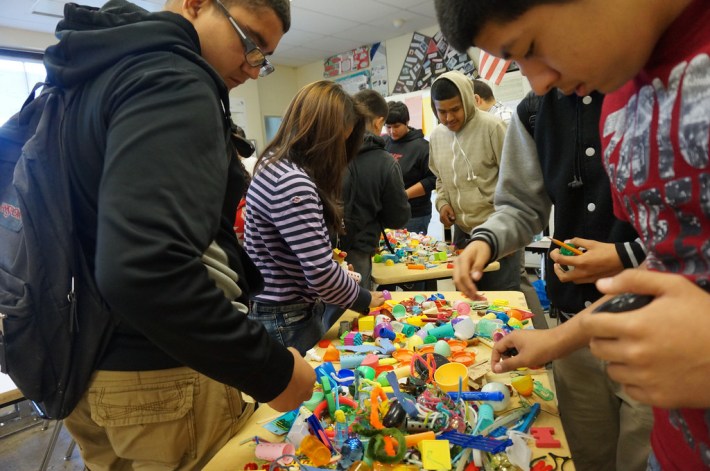
“Mister, who’s coming to class today?” asked a curious student from Gene Dean’s 9th grade English class at Roosevelt High School.
As the rest of the class began to take their seats, they took notice of the two tables filled with a random assortment of trinkets and knick-knacks, prompting another student to ask, “Are those toys for kids?”
Enter urban planner James Rojas, who excitedly engaged the students by asking them if they knew what an urban planner did.
Although the answers might have fallen into the category of "kids say the darndest things," the laughs broke up the awkwardness and allowed Rojas to introduce his interactive “Place It!” workshop. Three of Dean’s 9th grade English classes participated last Monday, a change from the normal routine of reading and essays that students clearly didn’t mind one bit.
Rojas describes his approach to workshops as one that offers “an opportunity for individuals to think critically about spatial organization and urban space and how it affects their everyday lives. The workshops are a means by which participants can imagine how their cities and neighborhoods could be organized differently.”
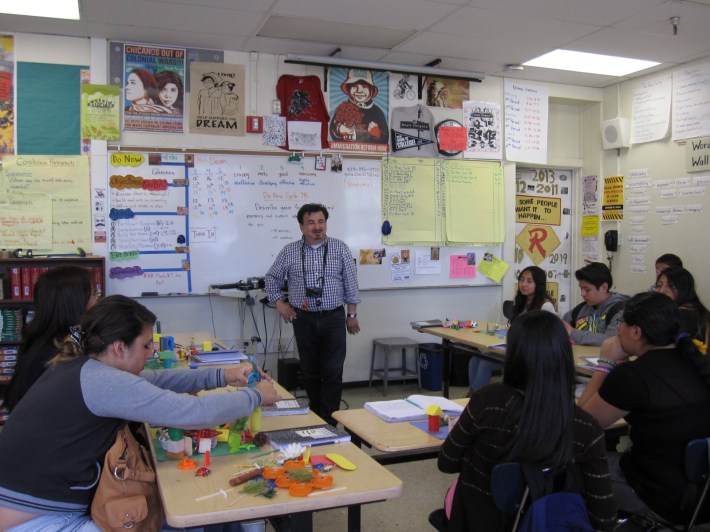
Having participated in several of Rojas’ workshops before, I knew that while his methodology and execution are consistent, no two workshops are ever the same, and therein lies the beauty of the approach.
The workshops started simply enough, with Dean asking his students to write about a favorite childhood memory in their journals. Rojas followed up by having the kids build small-scale models of their memory, using materials found on the tables.
While some of the kids bemoaned that they didn’t have a favorite memory or that they couldn’t remember anything, none seemed to have any problem scrambling toward the tables to rummage around for items to build with.
From happier memories of going to Disneyland, weddings, and holiday celebrations to more somber ones of family separation and painful accidents, students neither held back nor limited themselves.
“These memories illustrate how a child uses and values space in the community,” explained Rojas.
The creation of a safe space within the classroom allowed students to reflect on themselves, but also collectively as classmates, friends, neighbors, and individuals in the world. One by one, they bashfully shared their memory and model with the rest of the class, explaining little details so that their classmates could see what they saw.
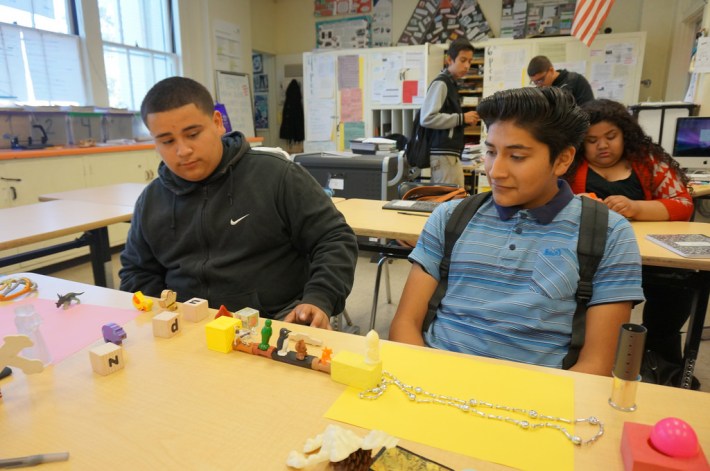
Once everyone was more comfortable with the concept of model-building, Rojas transitioned the students into the second activity by having them work in pairs. He asked them to think about specific streets and areas in Boyle Heights that they would want to change and/or improve.
By tapping into the students’ personal and detailed knowledge of their community, he was able to elicit an eclectic mix of ideas and re-imaginations of their neighborhood.
The first class focused more on issues of transportation and mobility. Students Alex Chupina and Javier Cortez depicted the Metro Gold Line with blocks acting as the train cars, beads as the rail, and an assortment of animals as passengers. Chupina said that they wanted to make transportation free so everyone could use it.
Some models re-envisioned train stations with more greenery and better connections to other trains and buses. Others thought that the idea of having toys available for children to play with would make the often long waits for transit a lot more bearable.
The discussion Rojas had with the class toward the end revealed that the majority of students and their families relied on public transportation, which no doubt influenced their focus on the need for safer, more reliable buses and trains.
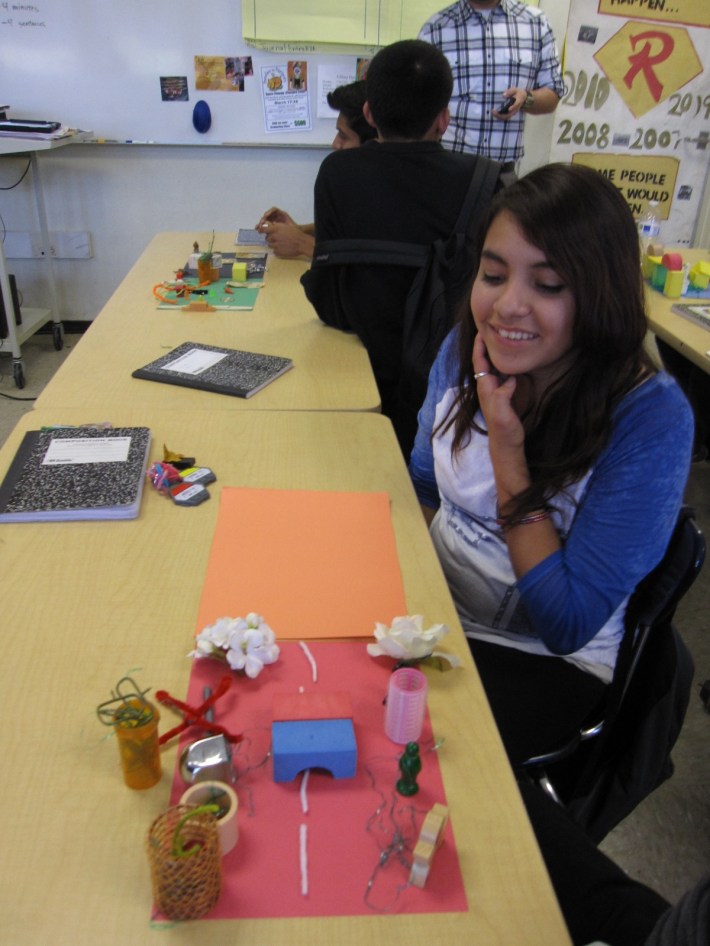
The second class created models focused on more tangible issues affecting access, including broken sidewalks, navigation of construction zones as a pedestrian, green spaces, and public safety.
Students Ashley Lopez and Michael Mazias recreated the Fourth Street Bridge and Lorena, the street running underneath it (for more on 4th/Lorena, see here). Lopez, who lives nearby, said she wanted to see more trees and greenery around the bridge since there’s nothing there but concrete and dirt.
Lopez and a handful of other students also described not feeling safe hanging out at the park or moving along poorly lit streets, narrow sidewalks, or filthy underpasses in the presence of people with clear substance abuse or mental health issues. As such, addressing the issue of homelessness figured heavily into the improvements they would make in their neighborhoods.
Toward the end of the class, when the students were asked if they took public transit or walked to school, the majority answered that they had a parent drop them off because it was either too far or unsafe.
The third class focused their models on more green space and parks in the neighborhood.
One of the models created turned a small area around the Sears Tower (on Olympic Blvd.) into a park with a lake. Another saw a football field in the neighborhood since the majority of parks in Boyle Heights are used for soccer and baseball. And, for the better part, they all shared some of the same ideas and concerns that the other two classes had already touched upon.
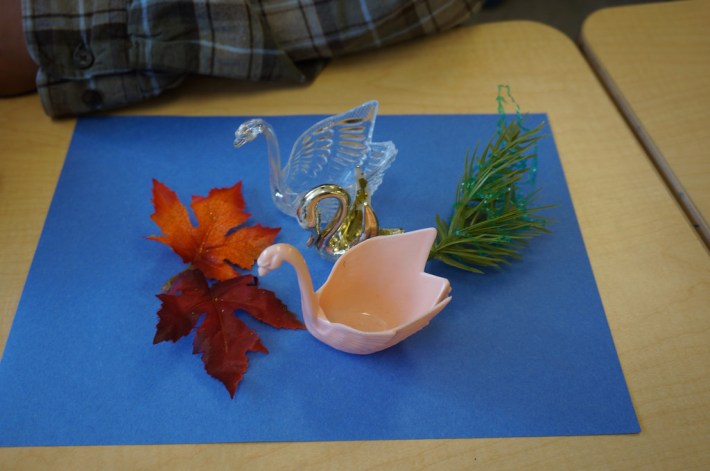
Much to the chagrin of his students, Dean asked them to follow up on the workshops by writing essays that not only reflected on their models, but that also considered the idea of shared space within a community and how changes in public safety, mobility, and access to resources might affect it.
This is only the beginning of a process Dean hopes will mature into his students becoming civically engaged with their community so they help make it a better place for everyone to enjoy.
As it is, how often are teens engaged in discussions about their neighborhood, let alone what they would want to improve in it by city planners and policy makers?
This is why Rojas hopes to makes the most of these workshops. By inviting the city planning department, Metro, and others to engage with the students, he looks to nurture the students' capacity for civic engagement and instill a belief that they, too, can have a say in the future of their community.






